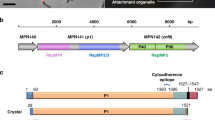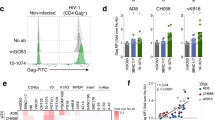Abstract
HOST defence against influenza A virus in experimental animals seems to be mediated mainly by antibody1,2. The mechanism by which antibody protects the host, however, is unknown. Antibody may either neutralise viral particles or recognise viral antigens at the surface of infected cells and then act at an early stage of infection, before viral replication is completed. The latter mechanism is theoretically more efficient, but might cause immunopathological destruction of the infected cells with harmful consequences. Viral envelope antigens (haemagglutinin and neuraminidase) have been shown to be present at the surface of influenza virus-infected cells, by haemadsorption3, electron microscopy4 and immunofluorescence5. Two main type-specific internal antigens have been described in influenza A virus—the matrix protein (MP) antigen6 and the ribonucleoprotein (NP) antigen7, a non-glycosylated polypeptide with a molecular weight of 58,000 (ref. 8). Immunofluorescence studies on fixed cells have shown that NP antigen is first demonstrable in the cell nucleus and then appears as granular masses within the cytoplasm, which become prominent at the, cell borders later in infection, suggesting a close association with the cell membrane9. We report here that NP antigen can be detected by immunofluorescence as early as 2 h after the infection on the surface of unfixed mouse cells infected with influenza A virus.
This is a preview of subscription content, access via your institution
Access options
Subscribe to this journal
Receive 51 print issues and online access
$199.00 per year
only $3.90 per issue
Buy this article
- Purchase on Springer Link
- Instant access to full article PDF
Prices may be subject to local taxes which are calculated during checkout
Similar content being viewed by others
References
Portnoy, J., Bloom, K. & Merigan, T. C. Cell. Immun. 9, 251–262 (1973).
Virelizier, J. L. J. Immun. 115, 434–439 (1975).
Pereira, M. S. Lancet ii, 668–669 (1958).
Morgan, C., Rifkind, R. A. & Rose, H. M. Cold Spring, Harb. Symp. quant. Biol. 27, 57–65 (1962).
Rutter, G. & Mannweiler, K. Arch. ges. Virusforsch. 43, 169–172 (1973).
Schild, G. C. J. gen. Virol. 15, 99–103 (1972).
Hoyle, L. & Fairbrother, R. W. J. Hyg., Camb. 37, 512–515 (1937).
Skehel, J. J. & Schild, G. C. Virology 44, 396–408 (1971).
Maeno, K. & Kilbourne, E. D. J. Virol. 5, 153–164 (1970).
Oxford, J. S. & Schild, G. C. in Negative Strand Viruses 2 (eds Mahy, B. W. J. & Barry, R. D.) (Academic, London, 1975).
Virelizier, J. L., Oxford, J. S. & Schild, G. C. Postgrad. med. J. 52, 332 (1976).
Dimmock, N. J. Virology 39, 224–234 (1969).
Skehel, J. J. Virology 49, 23–28 (1972).
Kurth, R. Nature 256, 613–614 (1975).
Hay, A. J. & Skehel, J. J. in Negative Strand Viruses 19 (eds Mahy, B. W. J. & Barry, R. D.) 635 (Academic, London, 1975).
Schulman, J. L. & Kilbourne, E. D. J. Bact. 89, 170–174 (1965).
Masurel, M., Baars, A. J. & Frankena, H. Antonie van Leeuwenhock 39, 461–471 (1973).
Oxford, J. S. & Schild, G. C. Virology (in the press).
Author information
Authors and Affiliations
Rights and permissions
About this article
Cite this article
VIRELIZIER, J., ALLISON, A., OXFORD, J. et al. Early presence of ribonucleoprotein antigen on surface of influenza virus-infected cells. Nature 266, 52–54 (1977). https://doi.org/10.1038/266052a0
Received:
Accepted:
Published:
Issue Date:
DOI: https://doi.org/10.1038/266052a0
This article is cited by
-
Seasoned adaptive antibody immunity for highly pathogenic pandemic influenza in humans
Immunology & Cell Biology (2012)
-
Protection of mice against an influenza virus infection by oral vaccination with viral nucleoprotein incorporated into immunostimulating complexes
Medical Microbiology and Immunology (1994)
-
Immunogenic properties of ISCOM prepared with influenza virus nucleoprotein
Archives of Virology (1990)
-
Recognition of influenza virus proteins by cytotoxic T lymphocytes
Immunologic Research (1987)
-
Oviposition deterrent from eggs ofCallosobruchus maculatus: Spacing mechanism or artifact?
Journal of Chemical Ecology (1987)
Comments
By submitting a comment you agree to abide by our Terms and Community Guidelines. If you find something abusive or that does not comply with our terms or guidelines please flag it as inappropriate.



